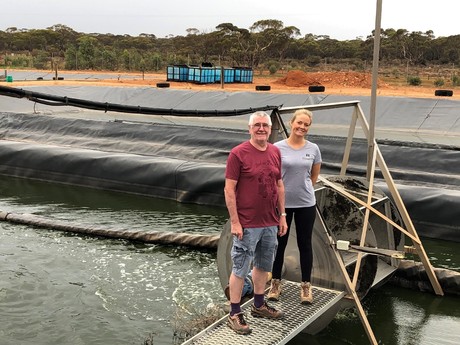Algae cleans up wastewater in rural communities

Flinders University researchers have confirmed that an improved wastewater system, using algae to accelerate the breakdown of effluent, presents Australian rural communities with a more environmentally and economically efficient solution.
Professor Howard Fallowfield, Professor in Environmental Health at Flinders University, has led research for the past 10 years into the use of high-rate algal pond systems (HRAP) for treating wastewater in South Australian rural communities. In 2016, the treatment system was accepted by the SA Department of Health Wastewater Management Group as an alternative to existing passive lagoon systems for use in South Australia.
Prof Fallowfield said the recent report on this research — Performance of a high rate algal pond treating septic tank effluent from a community wastewater management scheme in rural South Australia, by Neil Buchanan, Paul Young, Nancy Cromar and Howard Fallowfield (DOI: 10.1016/j.algal.2018.08.036) — confirms that the new HRAP system is smaller, faster and more effective at treating wastewater and creates the potential to reclaim more water for beneficial use.
“This system has the potential to dramatically increase the availability of water for re-use in rural communities,” Professor Fallowfield said. “These sustainable, low-energy systems are cost effective to run, and the capital cost of construction is also about 40% of the previous system for effluent-only schemes, and marginally higher for blackwater schemes.”
The study catalogues extensive testing of a HRAP system in a side-by-side trial with a conventional system at Loxton-Waikerie District Council’s Kingston-on-Murray site.
“The study demonstrated that high-rate algal ponds are a viable alternative to waste stabilisation ponds for the treatment of wastewater in rural South Australian communities and elsewhere,” said Prof Fallowfield.
“While a conventional system requires 66 days to treat the wastewater, HRAPs can perform a similar level of treatment in 5–10 days. Its ability to remove pathogens is equal to, or better than, existing wastewater systems.”
He added that by providing more reclaimed water to irrigate local woodlots, the new system is a winner, both environmentally and economically.
The study evaluated the performance of the HRAP over two years when fed 12 cubic metres a day of either treated effluent from on-site septic tanks, or a facultative pond further treating the septic tank effluent from the local community of 300 people. It showed that, generally, wastewater treatment and biomass production was improved when the HRAP was fed septic tank effluent.
- Wastewater from septic tanks was treated more effectively than from a facultative pond.
- 90% BOD5 was removed, mean biomass production was 31.7 g m−1 day−1, and only nitrogen removal was influenced by pond depth.
-
E. coli disinfection was acceptable when operated at 0.32 m depth and at four-day retention time.
The composition of the incoming wastewater affected the treatment performance; the stronger septic tank effluent was better treated and produced more algal biomass for subsequent exploitation than facultative pond effluent.
Centralised treatment systems are commonly installed in non-sewered (mostly rural) areas, generally where disposal of effluent by on-site systems is made difficult by space constraints, poor soil absorption, failed soakages or other issues that create a potential public health issue, with Prof Fallowfield issuing the warning that “if you are close to the Murray, where there are sandy soils, there is also the potential to contaminate the river and groundwater”.
He points to the substantial reduction in size compared to conventional systems as being a clear reason why the new HRAP system is particularly beneficial to non-sewered rural communities.
A first line of defence in wastewater screening
Two Queensland councils have opted for Australian-manufactured screening technology to protect...
Beef processor selects wastewater pump solution for dual purpose
John Dee Warwick wanted to upgrade its wastewater pump system to handle the day-to-day flows...
Melbourne Water finds an energy-saving solution
Sewage and wastewater treatment is a highly energy-intensive process, presenting a challenge for...







